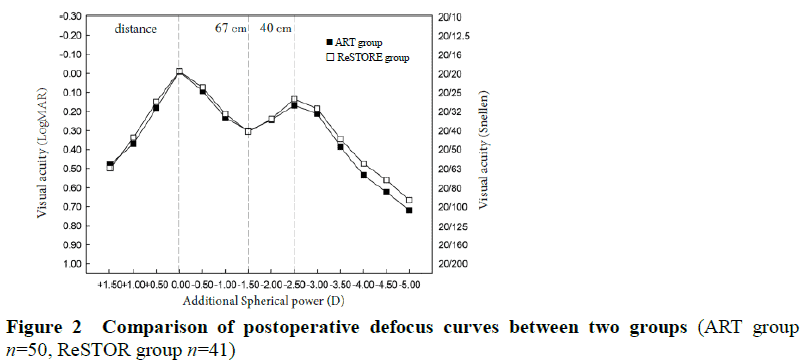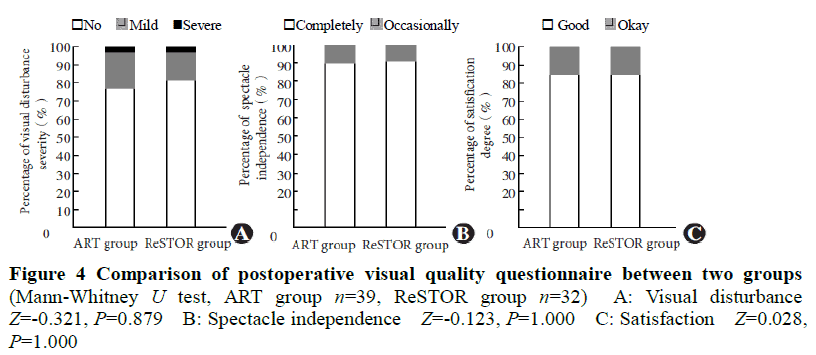Abstract [View PDF] [Read Full Text]
Objective
To evaluate and compare the postoperative visual quality after phacoemulsification combined with toric (ART) and non-toric (ReSTOR) multifocal intraocular lens (IOL) implantation.
Methods
A cohort study was conducted.Thirty-nine cataract patients (50 eyes) who underwent phacoemulsification combined with ART IOL implantation were enrolled as ART group, and 32 patients (41 eyes) who received ReSTOR IOL implantation were enrolled as ReSTOR group in Tianjin Medical University Eye Hospital from January 2017 to January 2018.Three months after surgery, the uncorrected distance visual acuity (UDVA), uncorrected intermediate visual acuity (UIVA) and uncorrected near visual acuity (UNVA), manifest refraction, defocus curve, contrast sensitivity (CS), modulation transfer function cutoff, Strehl2D ratio (SR), objective scattering index, OQAS values under 100%, 20%, 9% contrasts (OV 100%, OV 20%, OV 9%), total aberrations, total lower-order aberrations, total higher-order aberrations, spherical aberrations, coma and trefoil aberrations of the two groups were tested and compared.The study protocol adhered to the Declaration of Helsinki and was approved by an Ethics Committee of Tianjin Medical University Eye Hospital (No.2019KY[L]-04). Written informed consent was obtained from each subject prior to entering the cohort.
Results
UDVA at 3 months after surgery was (0.07±0.09)LogMAR and (0.09±0.12)LogMAR in ART group and ReSTOR group, and CDVA was (-0.01±0.07)LogMAR and (-0.01±0.07)LogMAR, and UIVA was (0.23±0.11)LogMAR and (0.22±0.13)LogMAR, and UNVA was (0.11±0.15)LogMAR and (0.06±0.11)LogMAR.UNVA was slightly better in ReSTOR group than ART group, and the difference was statistically significant (t=2.085, P=0.040). The mean depth of focus was (4.12±0.79)D in ART group and (4.24±0.95)D in ReSTOR group.The postoperative residual astigmatism (0.32±0.31)D was significantly lower than preoperative corneal astigmatism (1.27±0.40)D in ART group (t=13.209, P<0.001). CS values at 6, 12, and 18 c/d under photopic without glare, 12 and 18 c/d under photopic with glare, 3, 6, and 12 c/d under scotopic without glare in ART group were slightly lower than those in ReSTOR group, showing statistically significant differences (all at P<0.05) without clinical significance.SR and OV 20% values in ART group were 0.14±0.05 and 0.55±0.24, which were slightly lower than 0.17±0.06 and 0.66±0.29 in ReSTOR group, with statistically significant differences (t=-2.012, P=0.048; t=-2.557, P=0.043). Total aberrations and coma aberration under 5 mm pupil diameter in ART group were 0.88(0.59, 1.13)μm and 0.21(0.13, 0.30)μm, which were higher than 0.58(0.47, 0.74)μm and 0.10(0.08, 0.21)μm in ReSTOR group, showing statistically significant differences (Z=-2.073, P=0.038; Z=-2.101, P=0.036).
Conclusions
Cataract phacoemulsification combined with ART IOL implantation can provide good vision and visual quality while correcting preoperative corneal astigmatism, and the resolution in dim light or low to medium spatial frequencies is slightly weaker than eyes implanted with ReSTOR IOL.
Key words:
Figures and tables









Contributor Information
Tianjin Key Laboratory of Retinal Functions and Diseases, Tianjin Branch of National Clinical Research Center for Ocular Disease, Eye Institute and School of Optometry, Tianjin Medical University Eye Hospital, Tianjin 300384, China
Tianjin Key Laboratory of Retinal Functions and Diseases, Tianjin Branch of National Clinical Research Center for Ocular Disease, Eye Institute and School of Optometry, Tianjin Medical University Eye Hospital, Tianjin 300384, China
Tianjin Key Laboratory of Retinal Functions and Diseases, Tianjin Branch of National Clinical Research Center for Ocular Disease, Eye Institute and School of Optometry, Tianjin Medical University Eye Hospital, Tianjin 300384, China
Tianjin Key Laboratory of Retinal Functions and Diseases, Tianjin Branch of National Clinical Research Center for Ocular Disease, Eye Institute and School of Optometry, Tianjin Medical University Eye Hospital, Tianjin 300384, China